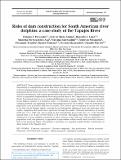Risks of dam construction for South American river dolphins : a case study of the Tapajós River
Abstract
River dolphins are strongly affected by the construction of hydroelectric dams. Potential isolation in subpopulations above and below such dams and the resulting low genetic variability of these subpopulations can cause extinction at a local level. Here we aimed to estimate density and population size of South American river dolphins (boto Inia geoffrensis and tucuxi Sotalia fluviatilis), map their distribution, and estimate potential biological removal (PBR) limits in order to evaluate the effects of population fragmentation between planned dams in the Tapajós River, Amazonian basin, Brazil. Boat-based surveys were conducted following a line transect sampling protocol covering different dolphin habitats in 2 stretches of the river divided by rapids. The mark-recapture distance sampling method was applied to account for animals missed on the trackline. After the estimation of population sizes by habitat, PBR was calculated. The farthest upriver sighting of tucuxis was close to the São Luiz do Tapajós rapids, whereas the farthest upriver sighting of botos was upstream of the rapids, suggesting that botos move upstream through the rapids. Estimated abundance of tucuxis (3372 ind., CV = 0.38) was twice as high as that estimated for botos (1815 ind., CV = 0.4). The PBR ranged from 11 to 18 ind. for boto and 21 to 34 for tucuxi. Throughout this study, we identified low abundances of river dolphins compared to other Amazon rivers. Boto may not be sustainable at a population level, due primarily to population fragmentation which would result from the construction of the proposed dams. Precautionary measures are urgently needed before construction of dams begins in the Tapajós River.
Citation
Pavanato , H J , Melo-Santos , G , Lima , D S , Portocarrero-Aya , M , Paschoalini , M , Mosquera , F , Trujillo , F , Meneses , R , Marmontel , M & Maretti , C 2016 , ' Risks of dam construction for South American river dolphins : a case study of the Tapajós River ' , Endangered Species Research , vol. 31 , pp. 47-60 . https://doi.org/10.3354/esr00751
Publication
Endangered Species Research
Status
Peer reviewed
ISSN
1863-5407Type
Journal article
Description
Funding: This study was funded by the Ministério da Ciência, Tecnologia e Inovação (MCTI) through Mamirauá Institute for Sustainable Development, with support from the Omacha Foundation (Colombia) and Whitley Fund for Nature.Collections
Items in the St Andrews Research Repository are protected by copyright, with all rights reserved, unless otherwise indicated.

